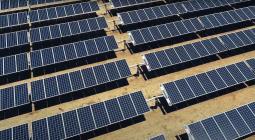CSIRO claims new record for energy efficiency in lightweight printed solar cells
Lead researcher says use of machine learning meant over 10,000 cells could be produced and tested in a day
Flexible, thin solar cells that are lightweight and portable may be a step closer to reality after Australian researchers claimed a new record for the amount of sunlight they can capture and turn into energy.
While traditional solar panels are rigid and heavy, the lightweight solar cells are made by printing ink on to thin plastic films.
“It’s the best demonstration that this is a viable method of making the solar cells,” said CSIRO’s renewable energy systems group leader, Dr Anthony Chesman.
The scientists, working in collaboration with researchers from four universities, claimed an efficiency record for fully roll-to-roll printed cells, in which all of the layers of the product were made using printing methods.
For a small-scale device they achieved efficiency of 15.5% and for a larger device measuring 50cm sq they achieved efficiency of 11%.
The results of the research have been published in the journal Nature Communications. Lead author and CSIRO’s principal research scientist, Dr Doojin Vak, said the efficiencies were made possible by integrating machine learning into the production process.
“We developed a system for rapidly producing and testing over 10,000 solar cells a day – something that would have been impossible to do manually,” he said.
Vak said the team’s research had also removed the need for some expensive materials in production of the cells, such as gold, by using specialised carbon inks that could reduce production costs.
The emerging technology still trails the efficiency of conventional silicon solar panels and its potential use in the market is still some years away.
But Chesman said there were potential real-world applications for the lightweight cells in settings where conventional solar power might be less suitable.
He said this included scenarios where solar power needed to be deployed and transported quickly, such as disaster relief, or at construction, mining or agricultural operations where portable power might be required.
“There are people who want to use solar in spaces where silicon isn’t suitable,” he said.
He said the next steps were working towards production at a larger scale and commercialisation.
CSIRO has commissioned construction of a pilot-scale printing facility – a larger-scale printer that will allow for printing of cells in a single line. The agency is also looking for industry partners to work with to further develop and commercialise the technology.
“We’re very interested in the niche applications we can move towards now,” Chesman said.
The chief executive of the Smart Energy Council, John Grimes, said the technology could be applied in settings where traditional solar panels were too heavy.
“A good application is in places like chicken farms where the structure is not engineered to take heavy solar on the roof,” he said.
“Another is in scenarios like emergencies where you need deployable power.”
Cover photo: Dr Doojin Vak says CSIRO’s flexible, thin solar cells do not need expensive materials, such as gold, in the production process. Photograph: CSIRO





